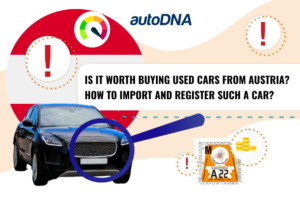
How to import European car to the US?
Table of Contents
Table of Contents
Import European car to the United States can be a rewarding experience, whether you’re looking to own a unique vehicle or bring your beloved European model with you when relocating.
European cars are known for their exceptional engineering, design, and performance, making them highly desirable in the U.S. market. Whether it’s a luxury sedan, a high-performance sports car, or a vintage classic, many car enthusiasts dream of driving a European model on American roads.
1. Check motor vehicles eligibility
Before you start the import process, it is crucial to ensure that your European vehicle meets the standards set by the U.S. Department of Transportation (DOT) and the Environmental Protection Agency (EPA). The U.S. government has strict regulations to ensure that imported vehicles meet safety and environmental standards to protect both drivers and the environment.
The model year of the vehicle can significantly impact its eligibility for importation, particularly in terms of meeting emissions and safety standards.
Which cars an be imported from Europe to the US?
Importing a car from Europe to the U.S. involves understanding which vehicles are eligible for importation. The U.S. Department of Transportation (DOT) and the Environmental Protection Agency (EPA) have stringent regulations to ensure that imported vehicles meet safety and environmental standards. To be eligible to import cars, a motor vehicle must comply with the Federal Motor Vehicle Safety Standards (FMVSS) and the EPA’s emissions standards.
For those vehicles manufactured that do not initially meet these standards, they can still be imported but must undergo modifications and be certified by a Registered Importer (RI) or an Independent Commercial Importer (ICI). This process ensures that the vehicle complies with all necessary regulations before it can be legally driven on U.S. roads permanently imported from.
Additionally, there is an exemption for certain vehicles that are 25 years old or older. These classic cars are not required to meet FMVSS and EPA standards, making them a popular choice for collectors and enthusiasts. This exemption allows for the importation of vintage models without the need for costly modifications.
2. Determine import method
There are several methods you personal use to import a car from Europe to the U.S., based on your purpose and intended duration of stay:
Knowing the specific location from which the vehicle is being imported is crucial to comply with U.S. Customs and Border Protection requirements.
Permanent import
If you intend to permanently register and use the foreign vehicle here in the U.S., full compliance with DOT and EPA regulations is mandatory. The vehicle must meet all safety, emissions, and operational standards to be legally driven on American roads. Individuals importing certain automobiles may be considered importers for tax purposes and must comply with federal emission standards. Permanent imports are often subject to modifications, including the installation of U.S.-approved safety and emissions equipment, which can be costly and time-consuming. It is essential to work with a Registered Importer (RI) to ensure compliance with all federal requirements before bringing the car into the country.
Temporary import
Non-residents can temporarily import a car for up to one year without meeting U.S. standards under certain conditions, such as:
- Tourism purposes: Visitors planning to use their vehicle for short-term travel within the U.S.
- Display in exhibitions or shows: Cars being imported for auto shows, racing events, or other temporary displays.
- Official use by diplomats or military personnel: Vehicles imported under diplomatic immunity or military programs.
A temporary import permit must be obtained, and the car must leave the U.S. before the permit expires. Failure to comply with these regulations may result in penalties or the confiscation of the vehicle.
Classic car exemption
Vehicles over 25 years old are exempt from FMVSS requirements but may still be subject to emissions regulations. This exemption is popular among collectors and enthusiasts importing vintage cars. These vehicles must be imported under the “classic and antique” vehicle category and must be primarily used for exhibition, club activities, or occasional transportation. Classic cars that qualify under this exemption may still need minor modifications to meet specific emission requirements and state-level regulations.
When importing classic cars, it is crucial to provide documentation verifying the vehicle’s age, such as the original title or original manufacturer’s certificate of origin. Additionally, some states have their own guidelines regarding emissions testing and safety standards for classic vehicles.
Choosing the right import method depends on your needs, budget, and intended use of the vehicle. Whether it’s a temporary or permanent import, understanding the various import rules and regulations will help avoid unexpected costs and delays.
3. Pre-import preparation
Before you embark on the journey of importing a car from Europe, thorough preparation is key. Start by researching the vehicle’s eligibility for importation to ensure it meets U.S. standards. Understanding the costs involved, including the shipping costs, import duties, and potential modification expenses, is crucial to avoid any financial surprises.
Gathering all necessary documents ahead of time will streamline the process. This includes the bill of sale, original vehicle title, and compliance forms. Choosing a reputable shipping company and customs broker can also make a significant difference in ensuring a smooth import process.
It’s highly recommended to study U.S. import laws and regulations to avoid any costly mistakes. By doing your due diligence, you can navigate the complexities of the importation process more effectively and ensure a successful outcome.
Your purchase options
When it comes to purchasing a car from Europe, you have several options to consider. You can buy from a private seller, a dealership, or an auction house. Each option has its own set of advantages and disadvantages, so it’s essential to weigh these carefully before making a decision.
Buying from a private seller might offer a better price, but it comes with risks such as limited recourse if something goes wrong. Dealerships often provide more security and may offer warranties, but they can be more expensive. Auction houses can be a great place to find rare or unique vehicles, but the process can be competitive and fast-paced.
Regardless of where you purchase the vehicle, it’s crucial to ensure that it complies with U.S. safety and emissions standards. You can request a certificate of compliance from the manufacturer or hire a third-party inspection service to verify the vehicle’s eligibility for importation. This step is vital to avoid any issues when the vehicle arrives in the U.S.
Hire a customs broker
Navigating the complex world of U.S. import regulations can be daunting, which is why hiring a customs broker can be a wise decision.
A customs broker is a certified professional who specializes in ensuring that your vehicle complies with all relevant regulations. They can assist with preparing the necessary documents required, clearing customs, and handling any issues that may arise during the import process.
By hiring a customs broker, you can save time and avoid costly mistakes. When contacting a customs broker, be sure to inquire about their experience with car imports and their knowledge of U.S. regulations. A knowledgeable broker can provide invaluable assistance, ensuring that your vehicle complies with all requirements and facilitating a smooth importation process.
3. Find a certified registered importer (RI)
If your vehicle’s manufacturer does not meet U.S. standards, you must work with a Registered Importer (RI) approved by the National Highway Traffic Safety Administration (NHTSA). The RI will help with:
- Making necessary modifications to comply with FMVSS, such as adjusting lighting, bumper structures, and crash protection features.
- Ensuring emissions compliance per EPA standards by modifying or replacing the catalytic converter, exhaust system, and fuel management systems.
- Handling all paperwork and approvals, including submitting compliance documents to the appropriate authorities and coordinating with customs for vehicle release.
Registered Importers have extensive experience dealing with the complexities of the import process and are familiar with the necessary technical and administrative requirements for such compliance. They can also provide consultation on potential challenges, such as state-specific regulations that may affect vehicle registration after importation.
Choosing the right RI is crucial to ensuring a smooth and efficient import process. It is recommended to work with a reputable and experienced importer who has a track record of successfully assisting customers in bringing vehicles into compliance with U.S. standards. Working with such an importation or RI can save time, reduce costs, and provide peace of mind that your imported vehicle meets all regulatory requirements.
For further assistance with compliance and modifications, contact a knowledgeable Registered Importer who can guide you through the import requirements and discuss your specific needs.
4. Gather required documentation
To import your European car, you’ll need detailed information to prepare the following documents:
- Bill of Sale: Proof of purchase and ownership, ensuring that all transaction details are accurate.
- Original Vehicle Title: To verify ownership and vehicle history, which must be clear of any liens or encumbrances.
- DOT and EPA Forms: Compliance declarations for import approval, certifying that the vehicle meets U.S. safety and emissions standards.
- Customs Entry Summary (CBP Form 7501): Required by U.S. Customs and Border Protection to legally bring the vehicle into the country.
- Shipping Documentation: Bill of Lading from the transport company detailing the shipping method and delivery timeline.
Additional documentation that may be required includes proof of insurance, import duty payment receipts, and any modification certificates provided by a Registered Importer. Ensuring that all paperwork is accurate and complete will help avoid delays in the importation process and prevent potential legal issues down the line.
Once U.S. Customs verifies that the vehicle meets EPA and DOT standards, you must submit a completed Customs Form 368.
5. Choose a shipping method to avoid dangerous pests
When transporting your car from Europe to the U.S., you can select one of the following methods:
Roll-on/Roll-off (RoRo)
A cost-effective method where the vehicle is driven onto the shipping vessel and off upon arrival. This is a popular option for standard vehicles.
Container Shipping
Offers better protection for the vehicle during transit but is more expensive. This option is ideal for high-value or classic vehicles.
Air Freight
The fastest but most expensive option, suitable for luxury or high-performance vehicles.
Choosing the right shipping method depends on your budget and the value of the vehicle.
Cleaning the undercarriage
One often overlooked but crucial step in importing a car from Europe is cleaning the undercarriage.
The U.S. Department of Agriculture requires that all imported vehicles be free of foreign soil and debris to prevent the introduction of dangerous pests into the country.
To comply with this regulation, you can hire a professional to steam-spray or thoroughly clean the undercarriage of your vehicle before shipment. This step is essential to ensure that your vehicle complies with U.S. regulations and to avoid any costly delays or issues at the port of entry.
By taking the time to clean the undercarriage, you can ensure a smooth import process and avoid potential problems that could arise from non-compliance with agricultural regulations. This simple yet important step helps protect the U.S. environment and ensures that your vehicle is ready for its new home.
6. Pay import duties and fees
When your vehicle arrives in the U.S., it is subject to import duties and taxes. Common costs include:
- Standard Import Duty: 2.5% of the vehicle’s value
- Trucks and Utility Vehicles: 25% duty
- Classic Cars (over 25 years): Often exempt from duties
Additional fees may include port handling charges, insurance, and brokerage fees.
7. Vehicle inspection and compliance modifications completed
Once the vehicle arrives, it may need to undergo inspections by U.S. authorities to confirm compliance with regulations. If necessary, modifications must be carried out by the RI, which may include:
- Installing U.S.-approved headlights and taillights
- Adjusting bumper standards
- Retrofitting emissions control systems
The extent of modifications will depend on the car’s original specifications and the differences between U.S. and European standards.
8. Obtain insurance and register the vehicle
After your new car has passes all inspections and meets compliance requirements, the next steps are:
- Get Auto Insurance: Required before registering the vehicle
- State Registration: Visit your local Department of Motor Vehicles (DMV) to obtain registration and U.S. license plates
Each state may have its own registration requirements, so check with your local DMV for specifics.
9. Compliance with emissions and safety inspections
Depending on your state, your dream car also may need to pass emissions and safety inspections before it can be driven legally.
10. Consider additional costs and timelines
Importing a European car to the U.S. can be expensive and time-consuming. Some additional costs to consider include:
- Shipping insurance
- Temporary storage fees
- Repair or compliance costs
- Legal consultation fees
Individuals returning from travel, work, or study abroad may qualify for certain customs exemptions when importing vehicles into the U.S.
The entire process can take anywhere from a few weeks to several months, depending on the vehicle’s compliance and shipping time.
Conclusion
Bringing a European car to the U.S. requires a thorough understanding of regulations, compliance requirements, and logistics. While the process to import cars can be complex, proper planning and working with experienced professionals can make it a smooth experience. Whether you’re importing a luxury car or a vintage model, following these steps will help ensure a successful car importation process.
At autoDNA.com, the market-leading VIN decoding tool, you can free VIN lookup on a given vehicle. All you need for this is the VIN number. In the reports, on used cars, you can find information that will allow you to check whether the seller is telling the truth or not. In the report, you can find data on various topics. One of them is the vehicle history or stolen vehicle bases. You can do a VIN check for free 24/7 throughout the year.















